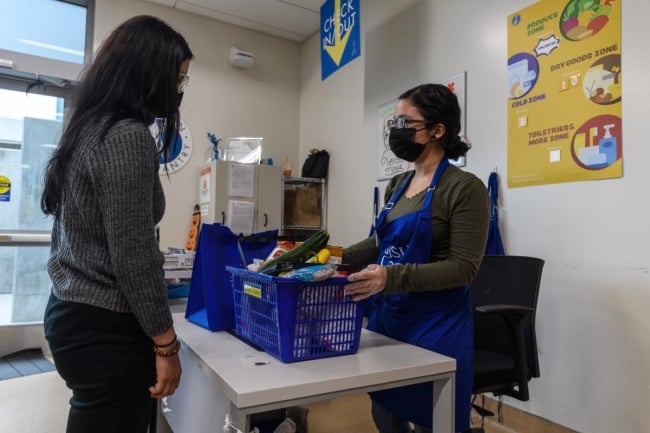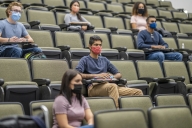You have /5 articles left.
Sign up for a free account or log in.

San José State University professors teamed up with a state lawmaker to find solutions to student homelessness and hunger.
Robert C. Bain/San José State University
Scott Myers-Lipton, a professor of sociology at San José State University, was dismayed to hear the same stories from his students semester after semester: students were routinely struggling financially; some were sleeping in their cars, “scared out of their minds” about their safety. Others were even spending nights in the campus library or the student union building.
When he co-authored the 2020 Silicon Valley Pain Index, an annual report on wealth and racial inequalities in the surrounding area, he found more than 4,000 students at the university experienced homelessness in the year prior to the survey. Half of the students surveyed reported eating smaller portions or skipping meals altogether because they couldn’t afford food costs.
Myers-Lipton and William Armaline, co-author of the report and director of the university’s Human Rights Institute, decided something had to be done. They turned to local, state, and federal lawmakers for help. The researchers set up a call with California state senator Dave Cortese, whose district includes San José.
“We said, ‘Here are the numbers. What ideas do you have to address the crisis around inequality … and racialized wealth inequality, income inequality?’” Myers-Lipton said.
Myers-Lipton didn’t expect the outcome of that September Zoom call—an idea by Cortese to conduct a pilot program to support low-income students by giving them monthly state assistance payments of $500. The program is modeled on universal basic income programs that have grown in popularity over the last five years and are used by municipalities and other government entities as a tool to reduce persistent poverty and economic inequality.
Myers-Lipton had not considered this option, but he liked the idea.
“I feel passionate about making sure our students have the best chance to get the best education possible,” said Myers-Lipton, who is also an advisory board member at the Human Rights Institute. “And they can’t get it if they’re hungry or they’re homeless—because their grades start to suffer incredibly. They start to spiral. I’ve seen it in my class.”
Cortese plans to propose legislation by mid-February that would provide the payments to low-income students on at least three CSU campuses, which have yet to be determined. The cash could go toward any expenses students choose. Cortese said the program could start as early as next fall or winter if his proposal is backed by his Senate and Assembly colleagues and wins the governor’s support. The plan was initially reported by the Los Angeles Times.
Up to 14,000 CSU students who have a family household income of up to $20,000 could qualify for the payments. It would cost the state about $57 million to run the program for a year on three campuses and about $84 million for five campuses, according to initial estimates from Cortese.
Cortese noted that universal basic income programs have become increasingly popular in California and nationwide. For example, the state’s budget last year included $35 million to start a guaranteed income pilot program focused on pregnant Californians and young adults who recently transitioned out of the foster care system. Cortese helped to develop that program.
“I think it’s becoming understood that a much more progressive and liberating and empowering way to deal with safety net need is to say, ‘Here’s a stipend. If you need it all for housing, use it for housing. If you need half for housing and half for food, that should be your decision. If you need shoes, go buy shoes,’” he said.
Cortese said the pilot program idea hasn’t received any pushback, as far as he knows. However, universal basic income programs in general face significant opposition from some conservative organizations and scholars.
“My reservations with UBI generally are, what happens to recipients when you give them money with actually no strings attached?” said Daniel Heil, a fellow at the Hoover Institution, a conservative public policy think tank at Stanford University. “What happens to their decisions to go out and pursue higher education, to develop new human capital skills? What happens to their decisions to work?”
But Heil said restricting payments to students alleviates his concerns. He believes the money could incentivize students’ academic progress and function as a more flexible but otherwise “classic” student aid program.
“In and of itself, giving money to low-income students to encourage them to continue in school and giving them the ability to do so, that’s a far cry from a UBI,” he said.
Cortese noted that California has a projected budget surplus—$45.7 billion, according to the governor’s proposed 2022–23 budget—and “now is the time” to invest in a such a program.
The surplus “does allow us flexibility as a state to experiment a little bit and stand up new programs like this. And if they work, then we can stick with them, and if they don’t, they should be sunsetted,” he said. “We’re not having to take away money from any other program to do this … It’s not going to break the bank. It’s a very, very small fraction of the overall state budget.”
Thomas Harnisch, vice president for government relations at the State Higher Education Executive Officers Association, said state lawmakers across the country are considering more innovative and expensive proposals to support higher education during the current budget cycle in response to surpluses boosted by federal COVID-19 relief dollars.
For example, Rhode Island’s proposed 2023 budget includes $22.5 million for “higher education academies,” which are targeted coaching and support programs for 1,000 incoming students per year. New Mexico lawmakers are considering legislation to expand free tuition for up to 35,000 students in fall 2022 at public colleges in the state, at a cost of $85.5 million.
Harnisch believes state budget surpluses offer lawmakers openings to propose creative—and sometimes costly—higher education initiatives, the outcomes of which can be tracked and replicated across the country if successful.
“The budget surpluses provide policy makers with a unique opportunity to test new approaches to raising educational attainment, closing equity gaps and growing the economy,” he said. “If these ideas, such as the one in California, do get enacted, other states are going to be watching them to see how they work out.”
He added that steep enrollment declines during the pandemic have also likely motivated state lawmakers to look for innovative ways to allocate state dollars to students’ needs.
“Necessity is the mother of invention,” Harnisch said. “Over a million fewer students [are] enrolled today than in 2019—that enrollment decline could have substantial detrimental effects on the American economy and American society.”
Sara Goldrick-Rab, founder and president of the Hope Center for College, Community, and Justice at Temple University, is in favor of the pilot program but believes the money would go further if given to California community college students, who are more likely to come from low-income households.
“The basic needs insecurity is higher” among those students, she said. “The unmet need is higher. The number of students in need is higher. And the [number of] students with children is higher.”
A 2018 report from the CSU chancellor’s office found that almost 11 percent of California State University students were homeless and more than 40 percent experienced food insecurity. A similar report that same year from the California Community Colleges chancellor’s office found that 14 percent of those students experienced homelessness and 56 percent were food insecure.
Cortese recognizes the needs of community college students and said if the initial pilot program is successful, he would be interested in including some California Community Colleges. Focusing on the CSU system was partly “human nature”—he was moved by the research and stories from CSU faculty—and partly to keep costs down, he added.
Goldrick-Rab also stressed that a guaranteed income program for college students requires careful planning to ensure students don’t face bureaucratic obstacles.
One of her main worries is low-income students receiving the payments could risk becoming ineligible for federal benefits, such as the child tax credit, Temporary Assistance for Needy Families or Pell Grants, as their incomes increase. She said a number of college districts across the country have expressed interest in similar guaranteed income payment models but have balked at “thorny questions” about potentially harmful unintended consequences.
“I support this fully and wholeheartedly, and I would simply ask that they pay really close attention to those interactions … so that students aren’t just getting one kind of money in lieu of another. It might actually end up reducing your eligibility for other dollars. That would be bad,” she said.
Myers-Lipton said he and Cortese are aware of these possible pitfalls and are working to find ways to ensure students don’t lose other benefits. He’s confident those details will be hammered out and believes the pilot program could ultimately make a “huge difference” for his students.
“My students are in crisis,” he said. “We have to do something to deal with the hunger and homelessness of my students and all the students within the CSU.”









